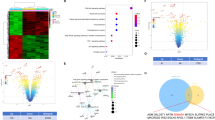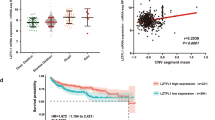Abstract
Human clear cell renal cell carcinoma (CCC) remains resistant to therapies. The transcription factor LIM-class homeobox gene Lim1 is required for normal organogenesis, including nephrogenesis, by regulating cell movements, differentiation and growth. Its expression is controlled partly by the sonic hedgehog-Gli signaling pathway, which we have recently shown to be reactivated in human CCC. So far, no study has assessed whether Lim1 may be associated with tumorigenesis. Using a panel of human CCC cell lines expressing or not the von Hippel-Lindau tumor suppressor gene and 44 tumor/normal tissues pairs, we found that Lim1 is constitutively and exclusively reexpressed in tumors. Through Lim1 silencing or overexpressing, we show that Lim1 is a growth and survival factor in human CCC, at least through the activation of oncogenic pathways including the phosphoinositide kinase-3/Akt and nuclear factor-kappaB pathways. More importantly, in nude mice bearing human CCC tumors, Lim1 silencing abolished tumor growth through the same mechanism as in vitro. In Lim1-depleted cells and tumors, cell movements were substantially impaired because of the inhibition of expression of various proteins involved in metastatic spread, such as paxillin or tenascin-C. These findings establish that the developmental marker Lim1 acts as an oncogene in cancer cells and targeting Lim1 may constitute an innovative therapeutic intervention in human CCC.
This is a preview of subscription content, access via your institution
Access options
Subscribe to this journal
Receive 50 print issues and online access
$259.00 per year
only $5.18 per issue
Buy this article
- Purchase on Springer Link
- Instant access to full article PDF
Prices may be subject to local taxes which are calculated during checkout








Similar content being viewed by others
Abbreviations
- CCC:
-
clear cell renal cell carcinoma
- Lhx1:
-
LIM-class homeobox gene 1
- SHH:
-
sonic hedgehog
- VHL:
-
von Hippel-Lindau
References
Agouni A, Sourbier C, Danilin S, Rothhut S, Lindner V, Jacqmin D et al. (2007). Parathyroid hormone-related protein induces cell survival in human renal cell carcinoma through the PI3 K Akt pathway: evidence for a critical role for integrin-linked kinase and nuclear factor kappa B. Carcinogenesis 28: 1893–1901.
Arsanious A, Bjarnason GA, Yousef GM . (2009). From bench to bedside: current and future applications of molecular profiling in renal cell carcinoma. Mol Cancer 8: 20.
Baldewijns MM, van Vlodrop IJ, Vermeulen PB, Soetekouw PM, van Engeland M, de Bruine AP . (2010). VHL and HIF signalling in renal cell carcinogenesis. J Pathol 221: 125–138.
Bar EE, Chaudhry A, Lin A, Fan X, Schreck K, Matsui W et al. (2007). Cyclopamine-mediated hedgehog pathway inhibition depletes stem-like cancer cells in glioblastoma. Stem Cells 25: 2524–2533.
Carroll VA, Ashcroft M . (2006). Role of hypoxia-inducible factor (HIF)-1alpha versus HIF-2alpha in the regulation of HIF target genes in response to hypoxia, insulin-like growth factor-I, or loss of von Hippel-Lindau function: implications for targeting the HIF pathway. Cancer Res 66: 6264–6270.
Chen J, Chen Z, Chen M, Li D, Li Z, Xiong Y et al. (2009). Role of fibrillar Tenascin-C in metastatic pancreatic cancer. Int J Oncol 34: 1029–1036.
Clark PE . (2007). Recent advances in targeted therapy for renal cell carcinoma. Curr Opin Urol 17: 331–336.
Dormoy V, Danilin S, Lindner V, Thomas L, Rothhut S, Coquard C et al. (2009). The sonic hedgehog signaling pathway is reactivated in human renal cell carcinoma and plays orchestral role in tumor growth. Mol Cancer 8: 123.
Escudier B, Cosaert J, Jethwa S . (2008). Targeted therapies in the management of renal cell carcinoma: role of bevacizumab. Biologics 2: 517–530.
Escudier B, Eisen T, Stadler WM, Szczylik C, Oudard S, Staehler M et al. (2009). Sorafenib for treatment of renal cell carcinoma: Final efficacy and safety results of the phase III treatment approaches in renal cancer global evaluation trial. J Clin Oncol 27: 3312–3318.
Friedrich CA . (1999). Von Hippel-Lindau syndrome. A pleomorphic condition. Cancer 86: 2478–2482.
Hall A . (2009). The cytoskeleton and cancer. Cancer Metastasis Rev 28: 5–14.
Huang D, Ding Y, Luo WM, Bender S, Qian CN, Kort E et al. (2008). Inhibition of MAPK kinase signaling pathways suppressed renal cell carcinoma growth and angiogenesis in vivo. Cancer Res 68: 81–88.
Hueber PA, Iglesias D, Chu LL, Eccles M, Goodyer P . (2008). In vivo validation of PAX2 as a target for renal cancer therapy. Cancer Lett 265: 148–155.
Hueber PA, Waters P, Clark P, Eccles M, Goodyer P . (2006). PAX2 inactivation enhances cisplatin-induced apoptosis in renal carcinoma cells. Kidney Int 69: 1139–1145.
Imao T, Egawa M, Takashima H, Koshida K, Namiki M . (2004). Inverse correlation of microvessel density with metastasis and prognosis in renal cell carcinoma. Int J Urol 11: 948–953.
Kaelin Jr WG . (2007). The von Hippel-Lindau tumor suppressor protein and clear cell renal carcinoma. Clin Cancer Res 13: 680s–684s.
Kawakami K, Hirata H, Yamamura S, Kikuno N, Saini S, Majid S et al. (2009). Functional significance of Wnt inhibitory factor-1 gene in kidney cancer. Cancer Res 69: 8603–8610.
Kobayashi A, Kwan KM, Carroll TJ, McMahon AP, Mendelsohn CL, Behringer RR . (2005). Distinct and sequential tissue-specific activities of the LIM-class homeobox gene Lim1 for tubular morphogenesis during kidney development. Development 132: 2809–2823.
MacLennan GT, Bostwick DG . (1995). Microvessel density in renal cell carcinoma: lack of prognostic significance. Urology 46: 27–30.
Massfelder T, Lang H, Schordan E, Lindner V, Rothhut S, Welsch S et al. (2004). Parathyroid hormone-related protein is an essential growth factor for human clear cell renal carcinoma and a target for the von Hippel-Lindau tumor suppressor gene. Cancer Res 64: 180–188.
Meng XN, Jin Y, Yu Y, Bai J, Liu GY, Zhu J et al. (2009). Characterisation of fibronectin-mediated FAK signalling pathways in lung cancer cell migration and invasion. Br J Cancer 101: 327–334.
Motzer RJ, Hutson TE, Tomczak P, Michaelson MD, Bukowski RM, Oudard S et al. (2009). Overall survival and updated results for sunitinib compared with interferon alfa in patients with metastatic renal cell carcinoma. J Clin Oncol 27: 3584–3590.
Nativ O, Sabo E, Reiss A, Wald M, Madjar S, Moskovitz B . (1998). Clinical significance of tumor angiogenesis in patients with localized renal cell carcinoma. Urology 51: 693–696.
Nogueira M, Kim HL . (2008). Molecular markers for predicting prognosis of renal cell carcinoma. Urol Oncol 26: 113–124.
Ohno Y, Izumi M, Yoshioka K, Ohori M, Yonou H, Tachibana M . (2008). Prognostic significance of tenascin-C expression in clear cell renal cell carcinoma. Oncol Rep 20: 511–516.
Reidy KJ, Rosenblum ND . (2009). Cell and molecular biology of kidney development. Semin Nephrol 29: 321–337.
Ryschich E, Khamidjanov A, Kerkadze V, Buchler MW, Zoller M, Schmidt J . (2009). Promotion of tumor cell migration by extracellular matrix proteins in human pancreatic cancer. Pancreas 38: 804–810.
Sagalowsky AI . (2002). The 1997 TNM classification of renal cell carcinoma revisited: the pendulum swings back. Curr Opin Urol 12: 371–373.
Schedl A . (2007). Renal abnormalities and their developmental origin. Nat Rev Genet 8: 791–802.
Shawlot W, Behringer RR . (1995). Requirement for Lim1 in head-organizer function. Nature 374: 425–430.
Sjolund J, Johansson M, Manna S, Norin C, Pietras A, Beckman S et al. (2008). Suppression of renal cell carcinoma growth by inhibition of Notch signaling in vitro and in vivo. J Clin Invest 118: 217–228.
Sourbier C, Danilin S, Lindner V, Steger J, Rothhut S, Meyer N et al. (2007). Targeting the nuclear factor-kappaB rescue pathway has promising future in human renal cell carcinoma therapy. Cancer Res 67: 11668–11676.
Sourbier C, Lindner V, Lang H, Agouni A, Schordan E, Danilin S et al. (2006). The phosphoinositide 3-kinase/Akt pathway: a new target in human renal cell carcinoma therapy. Cancer Res 66: 5130–5142.
Strutz F, Zeisberg M, Ziyadeh FN, Yang CQ, Kalluri R, Muller GA et al. (2002). Role of basic fibroblast growth factor-2 in epithelial-mesenchymal transformation. Kidney Int 61: 1714–1728.
Tang J, Wu YM, Zhao P, Yang XM, Jiang JL, Chen ZN . (2008). Overexpression of HAb18G/CD147 promotes invasion and metastasis via alpha3beta1 integrin mediated FAK-paxillin and FAK-PI3K-Ca2+ pathways. Cell Mol Life Sci 65: 2933–2942.
Venegas-Ferrin M, Sudou N, Taira M, del Pino EM . (2010). Comparison of Lim1 expression in embryos of frogs with different modes of reproduction. Int J Dev Biol 54: 195–202.
Yao Y, Pan Y, Chen J, Sun X, Qiu Y, Ding Y . (2007). Endoglin (CD 105) expression in angiogenesis of primary hepatocellular carcinomas: analysis using tissue microarrays and comparisons with CD34 and VEGF. Ann Clin Lab Sci 37: 39–48.
Acknowledgements
This study was sponsored by INSERM (Institut National de la Santé Et de la Recherche Médicale), by University of Strasbourg and by the French Ligue Contre le Cancer (Comités du Bas-Rhin et du Haut-Rhin et Comité National, recipient TM). We thank Dr A Donai for helpful suggestions, Dr J Barths for allowing us to perform FACS analysis and RA Hanna for text correction.
Author information
Authors and Affiliations
Corresponding author
Ethics declarations
Competing interests
The authors declare no conflict of interest.
Additional information
Supplementary Information accompanies the paper on the Oncogene website
Rights and permissions
About this article
Cite this article
Dormoy, V., Béraud, C., Lindner, V. et al. LIM-class homeobox gene Lim1, a novel oncogene in human renal cell carcinoma. Oncogene 30, 1753–1763 (2011). https://doi.org/10.1038/onc.2010.557
Received:
Revised:
Accepted:
Published:
Issue Date:
DOI: https://doi.org/10.1038/onc.2010.557
Keywords
This article is cited by
-
Differential gene expression and network analysis in head and neck squamous cell carcinoma
Molecular and Cellular Biochemistry (2022)
-
The integrated stress response is tumorigenic and constitutes a therapeutic liability in KRAS-driven lung cancer
Nature Communications (2021)
-
The Lim1 oncogene as a new therapeutic target for metastatic human renal cell carcinoma
Oncogene (2019)
-
Heterogeneity in retinoblastoma: a tale of molecules and models
Clinical and Translational Medicine (2017)
-
TFAP2B overexpression contributes to tumor growth and a poor prognosis of human lung adenocarcinoma through modulation of ERK and VEGF/PEDF signaling
Molecular Cancer (2014)



